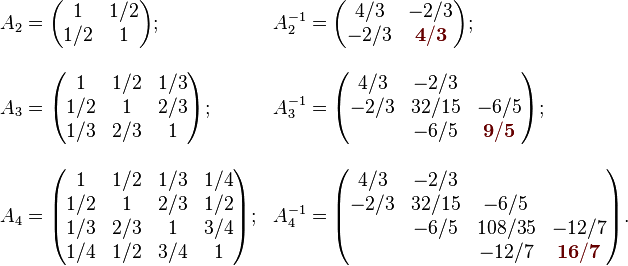Lehmer matrix
In mathematics, particularly matrix theory, the n×n Lehmer matrix (named after Derrick Henry Lehmer) is the constant symmetric matrix defined by
Alternatively, this may be written as
Properties
As can be seen in the examples section, if A is an n×n Lehmer matrix and B is an m×m Lehmer matrix, then A is a submatrix of B whenever m>n. The values of elements diminish toward zero away from the diagonal, where all elements have value 1.
Interestingly, the inverse of a Lehmer matrix is a tridiagonal matrix, where the superdiagonal and subdiagonal have strictly negative entries. Consider again the n×n A and m×m B Lehmer matrices, where m>n. A rather peculiar property of their inverses is that A−1 is nearly a submatrix of B−1, except for the An,n element, which is not equal to Bm,m.
A Lehmer matrix of order n has trace n.
Examples
The 2×2, 3×3 and 4×4 Lehmer matrices and their inverses are shown below.
See also
References
- M. Newman and J. Todd, The evaluation of matrix inversion programs, Journal of the Society for Industrial and Applied Mathematics, Volume 6, 1958, pages 466-476.


